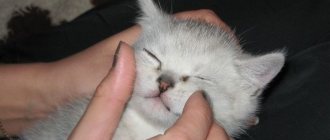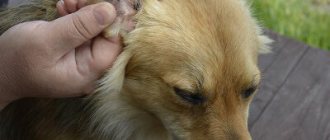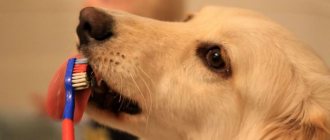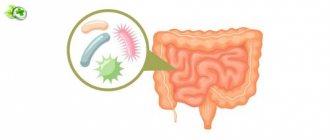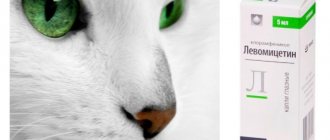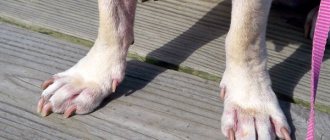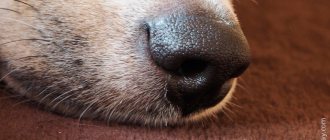Proper dog care
When the owner is attentive to the pet, most problems can be avoided. Care includes preventive measures and timely treatment.
Eye hygiene
Problems with the visual organs are more likely to occur in dogs with protruding eyes. But this does not mean that pets of other breeds do not require daily care.
Hygiene is performed using a special solution or using drops; warm boiled water is also suitable.
When carrying out the procedure, the following rules are observed:
- Apply a few drops of solution to a smooth cotton pad or sterile gauze swab;
- removal of impurities and dried exudate is carried out by moving from the outer corner of the eye to the inner;
- If the dog has long bangs, they are combed back and secured with hairpins before the procedure.
When your pet experiences intense lacrimation and dark crusts form in the corners, it is recommended to wash the eyes more often (2-3 times a day).
Preventive actions
It is easier to preserve your pet’s vision if you take measures to prevent negative factors. Prevention includes:
- mandatory eye hygiene, which reduces the risk of developing inflammatory processes;
regular examination of the organs of vision in order to study the shade of the conjunctiva and the presence of pus;- choosing a place to walk the animal, taking into account the risk of injury;
- periodic visits to the veterinarian to identify health problems;
- timely consultation with a doctor at the first signs of problems affecting vision.
During dog training, feasible exercises are selected that eliminate the risk of head and eye injuries.
When choosing a puppy, you should ask the breeder whether hereditary pathologies, such as cataracts, can develop.
Treatment
The dog’s vision will be preserved by timely therapy, but it must be prescribed by a specialist. Having noticed the first symptoms of pathology, the owner takes the pet to the doctor for a diagnosis and choice of therapy after examining the animal.
If the situation is not advanced, you can get by with medicinal drops. For inflammatory processes, antibiotics are prescribed. Corneal trauma and cataracts require surgery.
Treatment of conjunctivitis
Treatment of conjunctivitis in dogs depends on the form of inflammation, and in case of infectious etiology, on the type of pathogen:
- Catarrhal type. For traumatic conjunctivitis, symptomatic treatment and anti-inflammatory drugs are sufficient.
- Purulent inflammation, as well as parenchymal, chlamydial and fibrinous conjunctivitis. Antibiotics, anti-inflammatory drugs are prescribed, and symptomatic treatment is carried out, to which antipyretics are added.
- Allergic conjunctivitis. Symptomatic treatment is sufficient; antihistamines must be prescribed.
- Viral conjunctivitis requires antiviral agents. Symptomatic therapy and anti-inflammatory drugs are prescribed.
Symptomatic therapy
Elimination of symptoms is necessary so that the animal can more easily tolerate the disease. To do this, clear the eyes of exudate and prescribe painkillers and antipyretics.
Important! The use of human antipyretic and analgesic drugs for dogs is strictly prohibited!
A pet can get severe poisoning from Nurofen or Tetraflex, and fatalities are often observed from Aspirin. All these drugs cause severe gastrointestinal bleeding, turning the gastrointestinal tract into a sieve. You can only use special veterinary drugs, preferably the latest generation.
Drops
First of all, eye drops are used; they have a strong local effect and at the same time a complete absence of side effects and contraindications:
- Drops "Iris". A drug specially created for the treatment of conjunctivitis in pets. For dogs, 1-3 drops are enough, depending on the size of the pet; use 1-2 times a day until the symptoms disappear. There are no side effects if the dosages are observed. Not recommended for hypersensitivity to the product.
- Drops "Conjunctivitis". It is a complex remedy with analgesic, anti-inflammatory and bactericidal effects. Dosage: 2-4 drops in each eye 3-4 times a day. Use until symptoms disappear; if the dosage is followed, there will be no side effects.
- Drops "Maksidin". A complex drug with anti-inflammatory and antiviral effects. The product was created specifically for the treatment of conjunctivitis in patients. Dosage: 1-2 drops 2-3 times a day. There are no contraindications or side effects.
Treatment with folk remedies is possible. The most common are decoctions of chamomile or rose hips, as well as aloe and Kalanchoe juices. Dosages are the same - 1-3 drops several times a day. Decoctions and natural juices must be used only fresh.
Painkillers
For pain relief, only local anesthetics are used:
- A solution of 2% novocaine. 3-4 drops under the eyelid twice a day. The duration of the course is no more than five days. Side effects: allergic reaction (extremely rare).
- A solution of 2% lidocaine. For an analgesic effect, 3-4 drops are enough, the anesthetic effect lasts 10-15 minutes. Not recommended for pregnant and lactating animals. Possible side effects in the form of an allergic reaction, burning sensation.
Antipyretics
You can only use veterinary drugs and only the latest generation:
- Vedaprofen. A safe product designed specifically for dogs. Dosage: 0.5 mg/kg body weight per day, orally. The drug has a strong analgesic effect. Sometimes side effects such as gastritis are observed.
- Carprofen. The drug is also created specifically for dogs. It has a high degree of safety and has no contraindications or side effects. Has a strong analgesic effect. Dosage: 2-4 mg/kg body weight.
Anti-inflammatory drugs
Prescribed for severe inflammation. This group of drugs is needed to block the mechanism of development and spread of the disease. Use only under the supervision of a veterinarian, since anti-inflammatory drugs are very harmful to the health of the pet.
The most commonly used drug is Dexamethasone. It is a corticosteroid, so the dosage is prescribed by a specialist; usually 1-2 drops 3 times a day are enough until the swelling subsides and the itching disappears. Side effects are varied and depend on personal sensitivity. Use with caution; overdose can cause damage to the cornea.
Antihistamines
First of all, determine the cause of the allergy. The dog should be put on a diet and allergens should be excluded from the diet. The best option for natural food would be buckwheat or rice, maybe with boiled beef. They also thoroughly clean the room of dust and debris (especially construction debris).
The most suitable drug for dogs is Allervet 1%. It is an analogue of diphenhydramine, but is much safer for animals. It is administered intramuscularly. Dosage: 1 ml per 5 kg of body weight 2 times a day. To eliminate signs of allergy, 5-7 days of use are enough.
Antibiotics
Their use depends on the type of pathogen; when the first signs of the disease are detected, you can start with antibiotics in the form of drops. If the disease does not go away, then you need to switch to more serious systemic antibacterial drugs.
The most convenient form of antibiotics is in drops. The drug does not enter the bloodstream and does not harm the immune system. The most common means are:
- Leopard. Drop 2 drops into each eye 3-4 times a day (no more than 5 times). The duration of treatment is from 1 to 2 weeks. The course should be repeated after seven days for the chronic form. There are no side effects or contraindications.
- Iris. 1-2 drops 4 times a day. Course duration is from 7 to 10 days. There are absolutely no side effects. Contraindication is personal intolerance to gentamicin.
- Tsiprovet. Instill 1-2 drops for 1-2 weeks. No side effects were found. Contraindication is intolerance to ciprofloxacin.
- Dekta-2. Drop 2-3 drops into the eyes 2-3 times a day. The course of treatment is from 5 to 10 days. No side effects were observed. Contraindication is hypersensitivity to the active substance.
- Lacrican. Dosage: 1-2 drops 2-3 times a day. The duration of treatment is about one and a half weeks. No side effects were identified. Contraindication is personal intolerance to the drug.
- Conjunctivin. Apply the drug 1-2 drops up to 3 times a day. The duration of the course should not exceed 3 days. There are absolutely no side effects. Contraindication is hypersensitivity to the active substance.
- Conjunctivin (ointment). Place 2-3 drops of ointment in the corner of the eye 3 times a day for 10 days or until recovery. No side effects were found. Contraindication is personal intolerance to the drug.
- Lakrimin Aseptic. Instill 2-3 drops 3-4 times a day until signs of the disease disappear (but not less than 5 days). No side effects were identified. There are no contraindications.
- Mizofen (ointment). A small amount of ointment is placed under the lower eyelid twice a day. No side effects were identified. Contraindication is hypersensitivity to the drug.
- Optimmune (ointment). One centimeter of ointment is applied to the cornea after rinsing. Course duration is up to one week. Side effects: tearing, swelling of the eyelids. Contraindications: viral infections and fungus.
- Tetracycline ointment 1%. A little ointment is applied behind the lower eyelid and distributed with calm movements over the entire surface of the eye shell. Repeat the procedure up to 5 times a day for at least one week. It is advisable for the animal to wear a special collar so that it does not rub its eyes. There are no side effects. It is not recommended to mix with other topical eye medications.
You can use regular pharmacy eye drops, such as Floxan, Levomycetin, Tsiprolet and others. But human remedies are not entirely suitable for animals.
These drugs can cause side effects and allergies. The prescription of such medications, their dosage and treatment methods are determined only by a veterinarian.
Systemic antibiotics
This group of medications can harm the body, so they can only be used with the approval of a veterinarian:
- Tsiprovet. Intramuscular use at a rate of 5-20 mg/kg. The dose is divided into two parts and administered after the same period of time. The duration of treatment is one week. Adverse reactions: dehydration, kidney and liver problems may occur. The drug is contraindicated during pregnancy.
- Erythromycin. Effective against parasite infestation. Dose: 5-10 mg as an intramuscular injection once a day for at least 7 days in a row. If used for too long, problems with liver function may occur. There are no contraindications.
- Tetracycline. Dosage 5-10 mg/kg 3 times a day. Duration of treatment is up to 7 days. Sometimes side effects such as allergies occur. The product is contraindicated in pregnant animals.
Antiviral agents
Prescribed by a veterinarian based on the diagnosis and causative agent of the disease. Often, special drugs containing globulins against a specific virus are prescribed for treatment. But there are still broad-spectrum agents that are used quite often:
- Fosprenil. Used as an injection solution. The product is a clear, colorless or yellowish liquid. The drug increases the bactericidal activity of blood plasma and accelerates phagocytosis. If the dosage is observed, it has no side effects. Dose: 0.3 ml/kg for adult dogs and 0.2 ml/kg for puppies 3-4 times a day.
- Ribaflox. It is a combined antibacterial and antiviral agent. Available in the form of an injection solution. It is administered subcutaneously at a dose of 0.1 ml/kg body weight. Side effects such as diarrhea and constipation are possible; with prolonged use, thrombocytopenia sometimes develops. Cannot be used by puppies, pregnant or lactating females.
In veterinary medicine, drugs from the “human pharmacy” are often used. Tobrex is no exception. Let's figure out what these drops are and in what cases they can be used to treat dogs.
Eye drops for pets
If you notice vision problems in your pet, you should not use human drops for treatment: they do not take into account the physiology of the animal (despite the similarity of pathologies).
It is better to purchase products designed specifically for dogs.
| Name | Short description |
| Bar" | The therapeutic effect is provided by 2 ingredients - chloramphenicol and furatsilin. Drops recommended:
Anti-inflammatory and anesthetic properties help well in the treatment of eye injuries |
| Tsiprovit | The main function is antimicrobial. The action extends to a large list of pathogens, including antibiotic-resistant organisms - mycoplasma and chlamydia The drug is used as a preventive measure, as well as in the treatment of most eye pathologies. Ophthalmologists use it when preparing an animal for eye surgery and after surgery as a means of accelerating vision restoration. |
| Iris | Gentamicin sulfate is effective against a wide range of pathogenic organisms. The peculiarity of the therapeutic effect is associated with the penetration of the drug through the cornea and its concentration inside the eye. This makes it possible to effectively use drops for pathologies of varying severity. |
Despite the availability of funds, only a doctor should choose eye drops for a pet. The specialist is able to correctly assess the condition of the visual organ and prescribe appropriate therapy.
The owner can independently buy the drug Diamond Eyes, intended for daily care of the animal. This is not only a hygienic product - the drops have a bacteriostatic effect.
They will help reduce tearfulness, relieve itching and redness. Taurine and the antioxidants it contains make Diamond Eyes a good first aid remedy for minor problems. Recommended for the prevention of age-related disorders in older dogs.
Why do my dog's eyes fester?
In most cases, the cause can be viruses, bacteria, and fungi. Despite this, dogs most often suffer from eye infections due to an allergic reaction. You can suspect it if you have changed the food; perhaps it is not suitable for your dog. However, allergies can often be to pollen.
Why do a dog's eyes fester?
- In this case, dogs feel good in winter and autumn, but in spring, with the beginning of flowering of plants, the dog’s condition worsens, lacrimation and suppuration of the eyes are immediately observed.
- As for allergies to smoke or chemical vapors, in this case the dog usually starts sneezing and snorting through his nose. In addition to the development of allergies, conjunctivitis can be the cause of suppuration.
- Please note that in puppies, chronic conjunctivitis that does not go away for a long time may be a symptom of improper development of the tear duct. In this case, eye massage or puncture of the tear duct is indicated.
- In mature dogs, conjunctivitis can occur due to weakened immunity. This means it's time to give vitamin supplements.
Eyes turn sour
Burying drops correctly: algorithm of actions
When treating a pet, eye drops are used differently than during hygiene procedures.
Step by step steps:
- the assistant fixes the dog’s position, holding it by the collar (if necessary, put on a muzzle);
- use cotton pads or gauze wipes to treat the animal’s eyes;
Having fixed the pet’s muzzle with one hand, with the other they pull back the lower eyelid and apply a few drops of the product, trying to get it onto the eyeball or into the conjunctival sac;- After 2-3 minutes, without pressing, distribute the medicine evenly over the mucous membrane.
To protect the animal from additional infection, hands are treated with antiseptics before the procedure.
It is difficult to carry out manipulations without experience, so the initial stage of therapy should be entrusted to a veterinarian, carefully observing his actions.
How to put drops in a dog's eyes
The dog should be given eye drops when it is calm and relaxed. If the animal shows anxiety, you must first talk, stroke or calm it with other usual methods.
Then the small dog is taken on your lap, turning its back to you, and the large dog is seated on the floor, positioned behind it, so as not to frighten you with the sight of the medicine. After this, the manipulations are performed according to the following scheme:
- the eyes and periocular area are cleaned of accumulated secretions and dirt using a bandage soaked in warm boiled water or a medicine;
- with one hand, spread the eyelids, slightly pulling the lower one;
- the required number of drops are released from the bottle in the second hand into the conjunctival cavity;
- check whether the medicine got exactly behind the eyelid, and did not flow past, and if necessary, repeat the procedure;
- hold the dog for several minutes to prevent it from scratching its eye or shaking its head if discomfort occurs;
- The second eye is treated in a similar way.
Important! If a dog is prescribed treatment with two drugs at the same time, they should be instilled with an interval of at least 20 minutes. In most cases, eye drops with different effects are used, which can reduce the effectiveness of each other.
You should always monitor the condition of your dog’s eyes in order to notice and begin treatment in time, preventing the development of serious complications. There are a large number of ophthalmic drugs. Therefore, it is important to know which eye drops can be used for dogs at home to prevent, treat, or eliminate discomfort from foreign objects. In many cases, this can save the dog’s vision, health and even life.
Eye condition is one of the indicators of a dog’s health. They should be free of discharge, cloudy formations and other pathological signs. Irregular care can lead to loss of visual acuity and the development of dangerous infections. From the article you will learn what you can use to wash your dog’s eyes to prevent diseases.
Tip 1: How to instill ear drops
Ear drops are used to treat various diseases, ear mites, and also to soften wax plugs. Before you start using the drops
, consult with an ENT doctor, because any medications can cause harm to health.
Get the drops
from the refrigerator, it is not advisable to instill cold medication into the ears.
You can heat the product in warm water (you cannot heat it in boiling water), but make sure that the bottle is well closed, otherwise water will get inside and the drops
will become unusable. While they are warming up a little, start cleaning the ear canal.
Clean your ear with a cotton swab, and if you have pus discharge or too much wax, rinse with hydrogen peroxide. It will soften all deposits and bring them out. After rinsing, carefully remove any remaining peroxide from your ear with a cotton swab.
Lie on your side and instill the medicine. Massage your ear a little. Using a similar scheme, apply drops to the second ear. Even if the inflammatory process is in one ear canal, both need to be instilled, since they are interconnected. If you have used warming drops
, then put a cotton swab so that the product does not flow out and the warming effect is enhanced.
If you are putting ear drops into a small child's ear, be extremely careful. Do not clean the ear canal with a cotton swab, as you may damage the eardrum. Observe the dosage of drops. Read the instructions carefully before using the drug.
My dog's eye is festering, what should I do?
The most common ointments for conjunctivitis are antibacterial drugs.
The dog's eye is festering, what to do:
- Floxal, Colbiocin. These are drugs that are made on the basis of antibiotics. That is, they will be effective for infectious conjunctivitis, but are absolutely useless if the suppuration is caused by viruses or fungi.
- If it is a fungal infection, then Clotrimazole, Fucis, Miconazole .
- Acyclovir and Gerpevir cope well with viral infections caused by the herpes virus and other viruses of this group.
Suppuration
Please note that the packaging should indicate eye ointment, as these products can also be used to treat skin lesions. In this case, the concentration will be slightly different. In addition, eye ointments often do not contain drugs that can cause allergies.
How to apply eye drops?
There is a first time for everything, for example, many people have to put drops in their eyes for the first time. Its therapeutic effect even depends on how and how correctly you instill the medicine. Therefore, it is very important to know how to put drops into your eyes and how often. After all, if you do it incorrectly, the drops will not get onto the mucous membrane of the eye and the desired effect will not occur; in addition, you need to know about the frequency of instilling the medicine into the eyes.
How to put in eye drops: rules
Never rub your sore eyes with the inside of your finger. This can introduce bacteria into your eye. Therefore, before using eye drops, wash your hands thoroughly and rinse your eyes. Wipe them with a napkin, scarf, or cotton pad, as long as this handy product is disinfected.
Often the drops flow onto the person to whom they are buried, as well as onto his clothes. To prevent this from happening, place a piece of cotton wool or a cotton pad under the finger that pulls back the eyelid.
You need to tilt your head back, pull down the lower eyelid with your finger and look up. Place a couple of drops into the space in the inner corner of the eye near the lower eyelid.
Don't open your eyes yet. Lightly press the area of the inner eye and hold your fingers there for a while. This way you will increase the effectiveness of the drops and reduce the likelihood of side effects. Here's how to properly apply eye drops.
Putting drops in a child's eyes
With adults everything is simple. But how to put drops in the eyes of a child, especially a capricious one? The task ahead is not an easy one. Essentially, you need to perform all the same actions. But some children categorically do not like having eye drops put in their eyes. In this case, the baby needs to be held. One person holds, the other performs all the actions described above. Some try with persuasion and explanations. And not everything helps, with
Source
Diseases that cause inflammation
Common:
- Conjunctivitis (follicular, purulent, fibrinous, catarrhal, phlegmonous).
- Keratitis.
- Blepharospasm.
- Dermatitis of the century.
- Protrusion of the third eyelid.
- Blepharitis.
- Cataract.
- Uveitis.
- Dislocation of the eyeball.
Each disease has its own symptoms.
Conjunctivitis
This is an inflammation of the mucous membrane and inner part of the eyelid. All breeds are susceptible to the disease. The cause of the problem is infection.
When prolonged, conjunctivitis becomes chronic, which is more difficult to cope with.
Symptoms differ depending on the type of disease, but the main complaints are the same:
- swelling of the third eyelid;
- the eye is constantly watering;
- The animal behaves restlessly, rubbing its sore eye with its paw.
With such symptoms, you need to take action.
Keratitis
Keratitis is a lesion of the cornea, or more precisely, its upper layer. Sometimes the disease is a consequence of untreated conjunctivitis, as well as vitamin deficiency or infection.
It’s easy to identify the problem: a film forms on the animal’s eye, the dog more often uses its sense of smell to move around the apartment.
Types of keratitis:
- Deep. A veterinarian can identify the problem.
- Surface. The infection does not affect the deep layers and, with proper treatment, is eliminated quickly.
- Ulcerative. Appears in advanced situations.
- Spot.
- Purulent. The cornea is swollen, its color changes from light to yellow. There is pus coming out of the dog's eye.
- Uveal. Symptoms are mild.
- Vascular. There are many pronounced vessels on the cornea.
- Catarrhal. The cornea quickly becomes cloudy, turning blue or gray.
- Phlyctenulous. Characteristic of Eastern European, German Shepherds and Collies. As a result of the disease, small nodules appear on the cornea, gradually merging with each other. The cornea takes on a gray tint.
With timely treatment, the disease can be quickly treated.
Blepharospasm
With the development of this pathology, the animal's eyelid shrinks uncontrollably, causing the four-legged friend to constantly blink. Sometimes the eye swells and photophobia occurs.
The dog's eyes are watering. When touched, the dog may experience pain or discomfort, which is expressed in whining.
There are several reasons for the occurrence of blepharospasm, ranging from mechanical damage and congenital defects to the inflammatory process occurring in the body. If left untreated, the disease will lead to blindness.
Dermatitis of the century
With dermatitis, the eyelid swells and becomes red. At the next stage, purulent accumulations appear in the corners of the eyes, and the skin on the eyelids peels off greatly.
If the problem is not treated, the eyes will become covered with pus, conjunctivitis will develop, and the eyelids will become swollen. The disease occurs in animals with floppy ears and long hair.
Third eyelid prolapse
It's easy to spot the problem. In dogs, a third eyelid appears at the bottom of the eye, the eyeball swells and turns red. The cause of the disease is infection. Less commonly, the disease is hereditary.
Considering that during illness the mucous membranes dry out greatly, they should be constantly moisturized, because one problem entails others: conjunctivitis and diseases of the cornea of the eye. To moisturize, you should use special eye drops.
The disease can only be eliminated through surgery.
Blepharitis
Blepharitis is a complex disease, as a result of which both skin and subcutaneous integuments are involved in the process. At first, the eyelid turns red, then begins to swell. After some time, you can notice a scab on it.
Purulent discharge appears from the eyes. Sometimes the disease appears due to other diseases associated with the cornea. The causes of blepharitis are hereditary factors, mites and other skin parasites, allergies.
The disease should be eliminated immediately after the first symptoms appear, because the problem can lead to serious consequences.
Cataract
Cataracts are a disease that is most often inherited. The disease develops slowly. At the initial stages, it is impossible to notice that something wrong is happening to the animal. Over time, the eye becomes swollen and a thorn appears on it.
This occurs as a result of lightening of the lens, as well as its inflammation. This entails an increase in intraocular pressure.
The problem is that at first the four-legged friend sees worse, then he can only distinguish outlines and silhouettes, and then he becomes completely blind.
